Videos - Gaia
Videos & Animations
This page contains a selection of Gaia videos and animations. For a full list of Gaia videos produced by ESA, visit the ESA Space in Videos website. A number of Gaia videos have also been uploaded to ESA's YouTube Channel.
Gaia Data Release 3: The asymmetric Milky Way in motion
Video highlighting the results from the paper "Gaia Data Release 3: Mapping the asymmetric disc of the Milky Way" by the Gaia Collaboration, Drimmel, R., et al. 2022. Credit: ESA/Gaia/DPAC, CC BY-SA 3.0 IGO. Acknowledgements: Created by Alex Lobel using Gaia Sky and GIMP. French and Dutch versions of this video are available here.
More information: Do the stars approach us or do they move away? the Gaia DR3 radial velocities bringing the third velocity component
Date: 13 June 2022
Gaia Data Release 3: Gaia's velocity map
Animation comparing the kinematics of the Milky Way from the APOGEE DR17 line-of-sight velocities and spectro-photometric distances derived from astroNN neural-network (Leung & Bovy, 2019) with the corresponding plot derived in the paper: "Gaia Data Release 3: Mapping the asymmetric disc of the Milky Way" by the Gaia Collaboration, Drimmel, R., et al. 2022. Credits ESA/Gaia/DPAC - CC BY-SA 3.0 IGO, using figures from the paper by the Gaia Collaboration, Drimmel, R., et al. 2022. ; and from Leung+2022. Acknowledgements: M. Romero-Gómez, L. Chemin.
More information: Do the stars approach us or do they move away? the Gaia DR3 radial velocities bringing the third velocity component
Date: 13 June 2022
Gaia Data Release 3: Chemistry of our Milky Way
Video highlighting the Gaia DR3 chemical cartography. Credits: ESA/Gaia/DPAC – CC BY-SA 3.0 IGO. Acknowledgements: Based on the paper by the Gaia Collaboration, Recio-Blanco, et al. 2022. Main Video / Data sets: ESA/Gaia/DPAC, Stefan Jordan, Toni Sagristà, Alejandra Recio-Blanco, Pedro Alonso Palicio, Patrick de Laverny, Paul McMillan. Narrator: Paul McMillan. Video of focal plane: ESA. RVS spectrum animation: ESA/Gaia/DPAC/CU8-CU6, Alejandra Recio-Blanco and the GSPspec team. Created with Gaia Sky, developed by Toni Sagristà. Music "Cannon" by Johan Pachelbel, interpreted by Jean-Baptiste Bourrel and Alejandra Recio-Blanco, recorded and mixed by Didier Farrugia, music artist advisor Claude Galvez.
More information: What are the stars made of? A chemical map with Gaia DR3
Date: 13 June 2022
Gaia's Early Data Release 3 Acceleration of the Solar System
More information: Gaia EDR3 story "Gaia's measurement of the Solar System acceleration with respect to the distant universe"
Copyright: ESA/Gaia/DPAC, CC BY-SA 3.0 IGO
Acknowledgements: S. Jordan, T. Sagristà, created with Gaia Sky. Based on Gaia Collaboration, Klioner et al., 2020, "Gaia Early Data Release 3 Acceleration of the solar system from Gaia astrometry", A&A
Date: 3 December 2020
More information: Gaia EDR3 story "Gaia's measurement of the Solar System acceleration with respect to the distant universe"
Copyright: ESA/Gaia/DPAC, CC BY-SA 3.0 IGO
Acknowledgements: S. Jordan, T. Sagristà, created with Gaia Sky. Based on Gaia Collaboration, Klioner et al., 2020, "Gaia Early Data Release 3 Acceleration of the solar system from Gaia astrometry", A&A
Date: 3 December 2020
Gaia's Early Data Release 3 stellar motion
More information: Gaia EDR3 story "Following the journey of stars across the sky"
Copyright: ESA/Gaia/DPAC, CC BY-SA 3.0 IGO
Acknowledgements: The visualisation was created by Anthony Brown, based on an idea from Stefan Jordan, and with inputs from Tineke Roegiers, Xavier Luri, Eduard Masana, and Timo Prusti. Background colour image created by André Moitinho.
Date: 3 December 2020
Comparison of the Gaia DR1 TGAS catalogue with the Gaia DR2 catalogue
Copyright: ESA/Gaia/DPAC
Acknowledgements: Created by Stefan Jordan and Toni Sagrista-Selles using Gaia Sky
Date: 25 April 2018
Demonstration of parallaxes and proper motion in the northern sky
Copyright: ESA/Gaia/DPAC
Acknowledgements: Created by Stefan Jordan and Toni Sagrista-Selles using Gaia Sky
Date: 25 April 2018
Demonstration of parallaxes and proper motions - 360 degrees video
Copyright: ESA/Gaia/DPAC
Acknowledgements: Created by Stefan Jordan and Toni Sagrista-Selles using Gaia Sky
Date: 25 April 2018
Demonstration of the Large Magellanic Cloud rotation
Copyright: ESA/Gaia/DPAC
Acknowledgements: Created by Stefan Jordan and Toni Sagrista-Selles using Gaia Sky
Date: 25 April 2018
Tour through the Gaia DR2 asteroids
Copyright: ESA/Gaia/DPAC
Acknowledgements: Created by Stefan Jordan and Toni Sagrista-Selles using Gaia Sky
Date: 25 April 2018
--------------------------
Keeping Gaia's memory
ESA's Gaia mission is generating an enormous amount of data as it works to plot the position of a billion stars in three dimensions. But during pre-flight testing one of Gaia's memory modules – part of the spacecraft's onboard 'hard disk' – failed. ESA's Materials and Electrical Components Laboratory was called in to assess the failure, to see if it was a one-off or else caused by a general manufacturing issue. The team made use of their 3D X-ray Tomography Machine to perform non-destructive internal scanning of the module and pin down the source of the fault.
Copyright: ESA
Date: 24 June 2016
--------------------------
Time-lapse film Soyuz flight VS06, with Gaia
Soyuz VS06, with Gaia space observatory, lifted off from Europe's Spaceport, French Guiana, on 19 December 2013.
This time-lapse movie shows Gaia sunshield deployment test, the transfer of the Soyuz from the assembly building to the launch pad and the lift off.
Copyright: ESA–S. Corvaja, M. Pedoussaut, 2013
Date: 10 January 2014
Download: here
--------------------------
Gaia Launch Replay: Highlights
This video includes highlights of the launch webcast including lift-off from Kourou, the Soyuz mission, separation of Gaia and the successful entry into orbit.
Copyright: ESA / CNES / Arianespace
Date: 19 December 2013
Download: here
--------------------------
Gaia launch: Full replay
Watch the full replay of the launch coverage of ESA's billion-star surveyor Gaia. Liftoff occurred at 09:12UT/10:12CET on 19 December and the successful deployment of Gaia's sunshield was confirmed approximately 90 minutes later.
Copyright: ESA / CNES / Arianespace
Date: 19 December 2013
Download: here
--------------------------
Update from Kourou the day before launch day
This highlight video provides background scenes from Kourou, showing final integration of the launcher, installation of the aerodynamic fairing, mating of the upper composite to the launcher and roll out to the launch pad. It also includes statements by Giuseppe Sarri, ESA's Gaia Project Manager, and Timo Prusti, ESA's Gaia Project Scientist.
Copyright: ESA
Date: 18 December 2013
Download: here
--------------------------
Inside Gaia's billion-pixel camera (Focal plane)
ESA's Gaia mission will produce an unprecedented 3D map of our Galaxy by mapping, with exquisite precision, the position and motion of a billion stars. The key to this is the billion-pixel camera at the heart of its dual telescope. This animation illustrates how the camera works.
Copyright: ESA
Date: 30 November 2013
Download: here
--------------------------
Gaia: launch to orbit
Animation showing Gaia launch and journey to its operating orbit.
Copyright: ESA
Date: 29 November 2013
Download: here
--------------------------
Guide to our Galaxy
This virtual journey shows the different components that make up our home galaxy, the Milky Way, which contains about a hundred billion stars.
Copyright: ESA
Date: 21 November 2013
Download: here
--------------------------
Gaia - Unlocking the Milky Way
Throughout history astronomers from Hipparcos to the present day have looked to the stars to tell us something about the universe we inhabit in a bid to understand how we got here.
Copyright: ESA
Date: 18 November 2013
Download: here
--------------------------
ESA Gaia Technology video
Our Galaxy the Milky Way is made up of a hundred billion stars. To truly understand its evolution we need to know exactly where we stand in this mass of constantly moving and changing celestial objects. To do this, Astrometry, the science of measuring the position, distance and movement of stars around us, is just about to take a giant leap forward with the launch of ESA's new space telescope, Gaia. Gaia will make it possible to measure a billion stars of our Milky way.
Copyright: ESA
Date: 04 November 2013
Download: here
--------------------------
ESA Euronews: Mapping the Milky Way
Euronews report about the Gaia mission. "Mapping the Milky Way" is also available at http://www.euronews.com/2013/10/24/mapping-the-milky-way/
Copyright: Euronews
Date: 24 October 2013
Download: here
--------------------------
Video: Gaia Sunshield Deployment Time-Lapse Sequence (Kourou)
Time-lapse sequences from the deployment test of the Gaia Deployable Sunshield Assembly (DSA) on 10 October 2013 in the cleanroom at Europe's spaceport in French Guiana.
Since the DSA will operate in microgravity, it is not designed to support its own weight in the one-g environment at Earth's surface. Therefore, during deployment testing on the ground, the DSA panels are attached to a system of support cables and counterweights that bears their weight, preventing damage and providing a realistic test environment.
Once in space, the sunshield has two purposes: to shade Gaia's sensitive telescopes and cameras, and to provide power to operate the spacecraft. Gaia will always point away from the Sun, so the underside of the skirt is partially covered with solar panels to generate electricity.
Copyright: ESA
Date: 10 October 2013
Download: here
--------------------------
Animation: Gaia Scanning the Sky
This animation illustrates how Gaia will scan the sky during its all-sky survey.
Copyright: ESA - C. Carreau
Date: 26 June 2013
Download: low-res (mov, 28.7M); low-res (mov, 41.2M); high-res (mov, 44.2M); high-res (mov, 72.3M)
Animation (short version): low-res (mov, 14.5M); low-res (mov, 37.0M); high-res (mov, 41.1M); high-res (mov, 62.2M)
--------------------------
Gaia sunshade deployment animation
Animation showing the deployment of Gaia's sunshade. Full details here.
Copyright: ESA / ATG Medialab
Date: 11 June 2013
Download from here
--------------------------
Gaia launcher separation test & close-up view
This is a video of a test of the separation mechanism that will free Gaia from its launcher's upper stage being conducted at Astrium Toulouse. The Gaia Service Module (SVM) is suspended from an overhead crane with the Launch Vehicle Adapter (LVA) attached using a clamp band. Compressed gas is fed to the clamp band locking mechanism via a quick-opening valve. Gravity is used to effect the separation, with the springs that will be used during launch in place but locked so that they just touched the spacecraft's interface ring. As the LVA falls away from the SVM, it lands on a cushioned protector.
At the start of the close-up video, the threaded fasteners holding the clamp band closed can be seen near the top centre of the screen. Between them are the flywheel and its locking mechanism, with the hose that supplies the compressed gas.
After separation, the clamp band is retained on the LVA by a set of brackets. The now disengaged fasteners can be seen in the clamp band end plates.
For more information, visit the ESA Science & Technology pages.
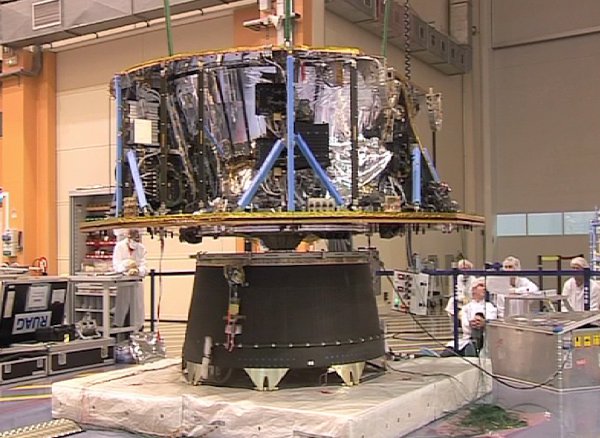
Copyright: Astrium SAS
Date: 29 October 2012
Download: mov (4.0 MB); mov (1.8 MB); mov (11.6 MB)
close-up video: mov (5.8 MB); mov (2.3 MB); mov (13.5 MB)
--------------------------
Gaia scanning law |
|
This movie shows the number of field transits (for both fields of view).
The movie has three intervals, interesting features to note are: 1) From 0 to 2 days:
The movie was made by scanning the central positions of each pixel of a healpix map of depth 8 (3.1 million pixels) with the scanner in AGISLab and taking the number of SM-observations (of which there is just 1 per field transit). Then the map was projected into a Hammer-Aitoff plot using the graphics library in GaiaTools. |
|
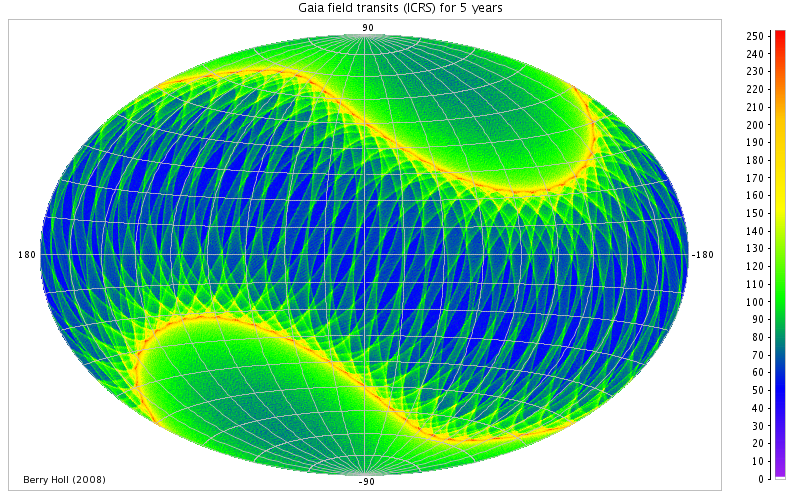 |
|
|
Copyright: Berry Holl Date: 25 November 2008; updated 1 February 2012 Download: mov (46.8M) |
|
| -------------------------- | |
Gaia Vodcast |
|
|
In this vodcast Rebecca Barnes discovers the motions of the stars, learns how astronomers measure their distances and looks at the new European mission that will really get to grips with our place in the Universe: Gaia. For more information, visit the ESA International Year of Astronomy website. |
|
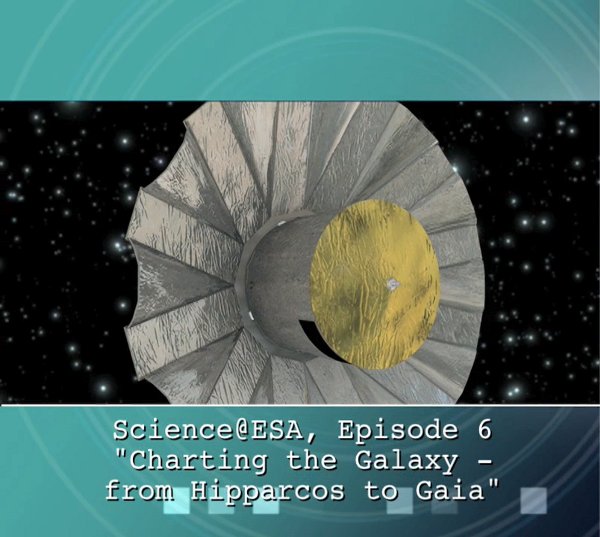 |
|
|
Copyright: ESA Date: 26 February 2010; updated 20 January 2012 Download: mov; mv4; wmv; mpeg |
|
| -------------------------- | |
Gaia Payload Module: X-axis vibration at qualification level |
|
|
In late June 2011, mechanical testing of the Gaia Payload Module was performed at the facilities of Intespace in Toulouse, France, under the direction of the Prime Contractor, Astrium. The results have been analysed and the testing was declared successfully completed. |
|
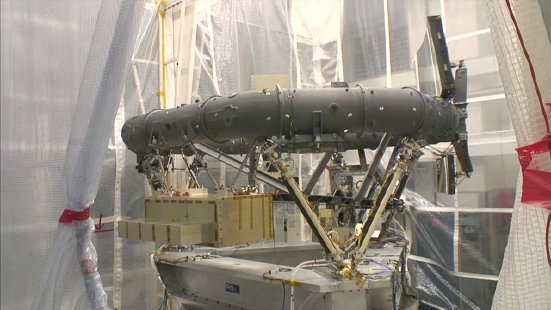 |
|
|
Copyright: Astrium, France Date: 27 June 2011 |
|
| -------------------------- | |
Gaia Payload Module: Z-axis vibration at qualification level |
|
|
In late June 2011, mechanical testing of the Gaia Payload Module was performed at the facilities of Intespace in Toulouse, France, under the direction of the Prime Contractor, Astrium. The results have been analysed and the testing declared successfully completed. |
|
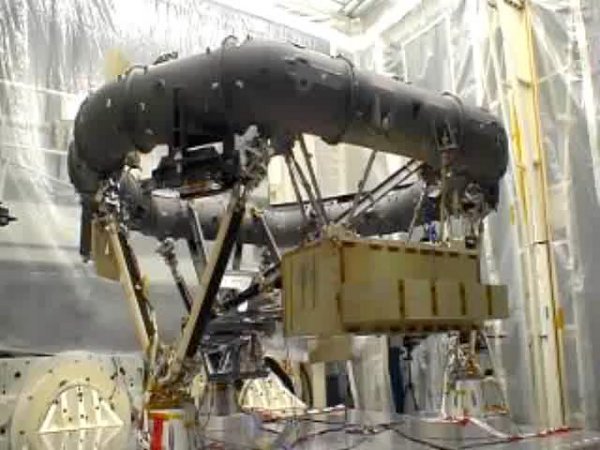 |
|
|
Copyright: Astrium, France Date: 27 June 2011 Download: mov (3.1MB); wmv (3.5MB); mov (8.5MB); wmv (9.0MB); wmv (9.6MB); wmv (9.7MB); wmv (9.7MB) |
|
| -------------------------- | |
Conjugate-gradients method for the global astrometric solution |
|
|
AGIS, the software system to produce the global astrometric solution for Gaia, uses a block-iterative scheme to perform the global astrometric parameter adjustment. In the framework of ELSA (the Marie Curie Research and Training Network associated with Gaia) it was investigated whether the usage of the conjugate-gradients method instead of a block iteration might give more pleasant convergence properties. |
|
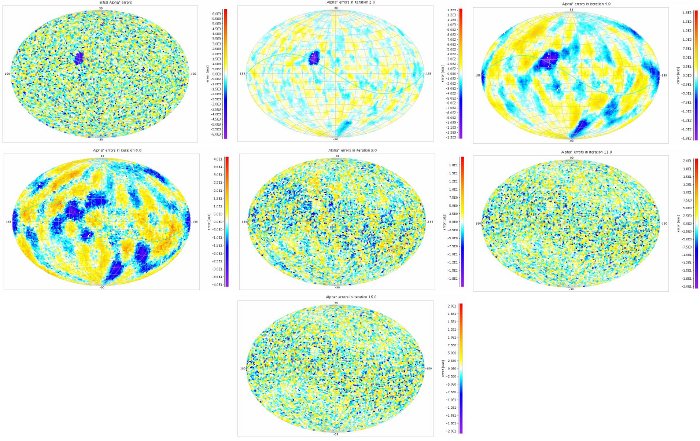 |
|
|
Copyright: A. Bombrun Date: 11 March 2009 Download: initial error map (png, 602KB); error map after 2 iterations (png, 501KB); error map after 4 iterations (png, 519KB); error map after 6 iterations (png, 568KB); error map after 9 iterations (png, 592KB); error map after 11 iterations (png, 591KB); error map after 16 iterations (png, 588KB); video (avi, 9.54 MB) |
|
| -------------------------- | |
Light bending by the Sun |
|
|
In this animation the positions of background stars are seen to move as a star in the foreground passes along the line of sight of the observer. |
|
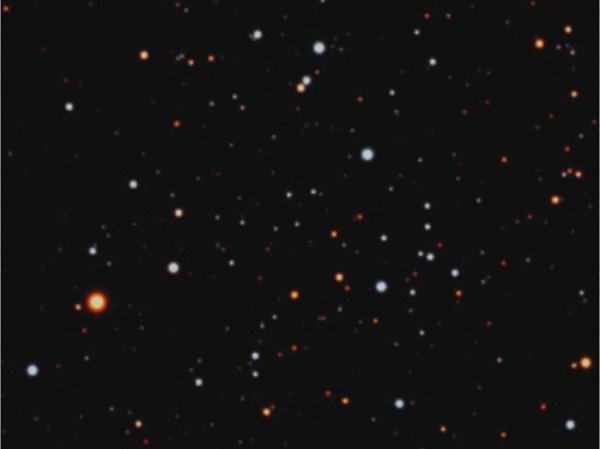 |
|
|
Copyright: ESA Date: 26 August 2005 |
|
| -------------------------- | |
The scanning law for Gaia |
|
|
Three animations illustrating the scanning law envisioned for Gaia have been created. Each animation shows the celestial sphere as viewed from the "outside". Gaia is at the centre of the box, which just encloses the celestial sphere. (The image above shows extracts from the animations - the original animations (in mpg format) can be viewed by following the links below.) |
|
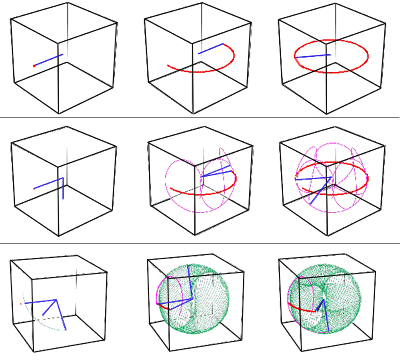 |
|
|
Copyright: Lennart Lindegren Date: 25 October 2004 Download: first animation (mpg, 1.3MB); second animation (mpg, 2.3MB); third animation (mpg, 5.4MB) |
|
| -------------------------- | |
Light bending in the Solar System |
|
|
At microarcsecond accuracy levels, such as those measured by Gaia, relativistic effects begin to play a considerable role. In particular, general-relativistic gravitational light deflection due to Solar System bodies will have profound effects on Gaia measurements over the planned 5 year lifetime of the mission. This is vividly illustrated in an animation, created by Jos de Bruijne, from which the image above has been extracted. |
|
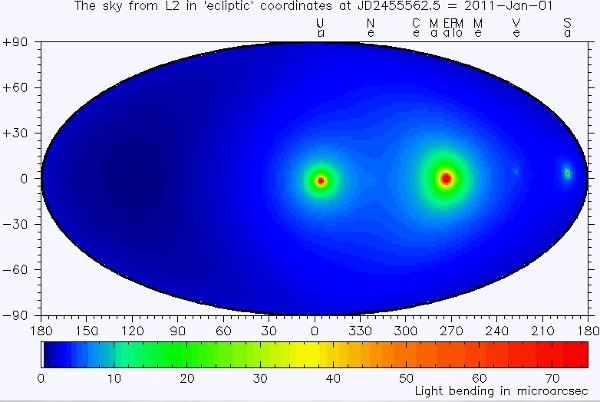 |
|
|
Copyright: ESA/Jos de Bruijne Date: 28 July 2003 Download: animated gif, (6.7MB); avi, (16MB) |
|
- Removed a total of (154) style text-align:center;
- Removed a total of (36) style text-align:justify;
- Removed a total of (1) border attribute.
- Removed a total of (1) cellpadding attribute.
- Removed a total of (1) cellspacing attribute.
Note on copyright: |
|
Some images contained in this Media Gallery have come from sources other than ESA (industry, the scientific community, etc), and this is indicated in the Copyright notice. For re-use of non-ESA images please contact the designated authority. Many other images in the Gallery have been released publicly from ESA. You may use ESA images for educational or informational purposes (non-commercial). The publicly released ESA images may be reproduced without fee, on the following conditions:
If ESA images are to be used in advertising or any commercial promotion, layout and copy must be submitted to ESA beforehand for approval. Contact If further information or assistance is needed, please contact us via the Gaia Helpdesk. |
- Removed a total of (1) border attribute.
- Removed a total of (1) cellpadding attribute.
- Removed a total of (1) cellspacing attribute.
ESA Space in videos
Find a large selection of published videos related to Gaia here.
ESA youtube channel
Find Gaia related videos from ESA's YouTube channel
Gaia playlist of the ESA YouTube channel
Gaia mission youtube channel
Find here additional videos published on Gaia Cosmos webpages through the Gaia Mission youtube channel.








































 Sign in
Sign in
 Science & Technology
Science & Technology
